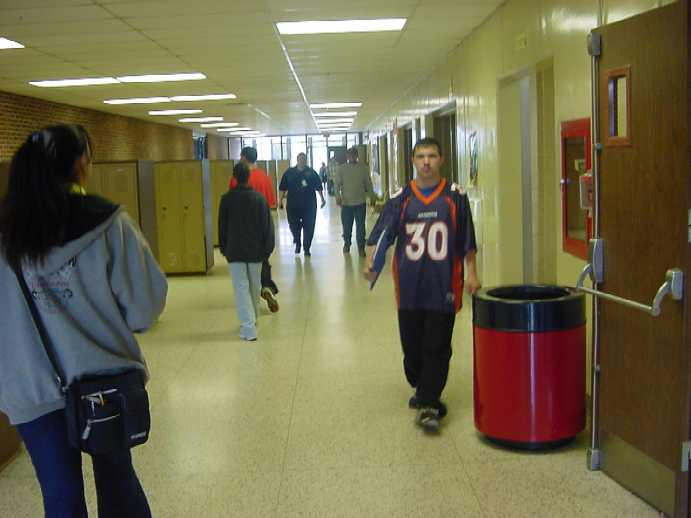Solution: Part I
The solution I created is a two part proposition that attends to the problems of Puerto Rican women and adolescents. The first aspect of the proposal is to add a weeklong required seminar educating freshmen at Lincoln West high school about issues of sexuality and risk prevention. The second part is aimed at the female adult population includes adding an assertiveness seminar program at The Free Health Clinic of Greater Cleveland while providing day care and operating at hours when people do not generally work.

Part I : High School Seminar
Lincoln West high school is situated in the center of the Clark-Fulton neighborhood and is part of the Cleveland Metropolitan School District (13). It is rich in diversity, 53% Hispanic, 22% black and 20% white. 35% of the students have limited English proficient skills (35). 100% of the students who attend this school are economically disadvantaged, compared to the state average of 35% (25). Health class is a half semester requirement in order and covers a variety of topics from depression to nutrition (25). Two weeks are spent on STDs and four days are designated to the discussion about AIDS (18). After interviewing the health teacher, Mr. Julius, I encountered two massive faults of the Health curriculum at Lincoln West High School. First, because the school is poorly funded, the recently had to cut back in teachers and other employees which forced the health curriculum to be a 12th grade class. Introducing awareness about risks in sexual behaviors when the students are 18 years of age is senseless because at 18 years of age, 48% of females and 51% of males have engaged in sexual intercourse (22). The second major fault with the health curriculum is that it is an abstinence based class. The Cleveland Metropolitan School district has decided to take an abstinence approach to all high school programs which greatly affects the education and information the students receive about the spread of STDs. Since Mr. Julius estimated about 15 students at the school are currently pregnant, it is clear that many students do not adhere to the abstinence disposition that governs the schools health program (18).

In order to change the conditions concerning the lack of information communicated to students about STD and HIV prevention, a week long course needs to be implemented and required for all freshmen. The course would occur during lunch periods within the first month of school and would provide a healthy meal for each student. It would be divided by sex to make conditions less awkward for the students. The course would be administered by a trained HIV/AIDS professional who specializes in communicating with inner city adolescents. The first few days of the class would discuss sexual pressures. The girls would focus on control in relationships and self confidence. There would be a sharing period where girls would talk about ways they have felt insecurity and self doubt. Then second stage would encompass AIDS education and intervention. This phase would educate the students about AIDS/HIV and other risks. Education would occur through a variety of means in order to reach both the Spanish and English speaking students. This section of the course would be mainly visual, using a number of photos, slideshows, movies, models, etc.

Determining the Intervention aspect of this seminar is more difficult. How the intervention is conducted is dependent on how far the rules applied to the public school health curriculum can be stretched. There are two types of risk-reduction approaches that are possible: information-based and, skill based risk-reduction (16). Information based reduction includes discussing vulnerability to HIV and STDs as well as transmission. It is important to try and make the discussion as personal with students as possible reinforcing that they are at risk (16). This method also discusses the responsibility for sexual risk reduction in romantic relationships and the importance of using condoms (16). There might be some tension with the administration due to the fact condoms are discussed and personal vulnerability is addressed but it the course in general should maintain most of the standards a normal health class would. The second approach, however, is extremely controversial. Skill based risk reduction intervention includes the information based reduction curriculum along with a few other lessons. The class would address elevated HIV and STD risk among inner city Latinos and discuss how drug and alcohol use and affects the decision making. Most importantly the students would handle condoms and engage in role playing to increase skills in using condoms as well as practice decision making in sexual situations (16). I need to stress the importance taking a skills based risk reduction approach to this class because it has greater positive effects on Puerto Rican adolescent girls. In a study conducted with inner city Latino adolescents who were mostly Puerto Rican, skill based intervention, compared to information based, drastically reduced the reported use of alcohol and drugs during sexual activity (16). Participants in the skill based were less likely to report multiple partners and fewer sexual partners. They were also significantly less likely to have an STD than the control group (10.5% compared to 18.2%). No significant differences occurred in the information based intervention proving it was not as successful (16). Forcing the administration to allow a program with Skills-based intervention would be a struggle, but the results would be well worth it.

1527 students attend Lincoln West high school, so each weeklong seminar would be composed of about 380 students (35). Lunch would cost around $5 per student, so one week’s worth of lunch would cost $9,500. The estimated salary of an HIV/AIDS specialist is $42,000 (38) so for a week lecture the estimated cost is $807. A budget of $2,000 would be allocated for supplies. The total cost of the weeklong freshmen health seminar would cost $12,307, which benefits the states budget on public healthcare. The average person infected with HIV/AIDS receives 22 -24 years of treatment. If a student becomes infected in high school and finds out five year later, they would most likely have a minimum of 12 years of treatment which would be $214,000 (7). Because all of the students are economically disabled (35), the cost of treatment would be a burden to the state and would take funds from the Cleveland AIDS taskforce. If this program prevents 15 cases of HIV/AIDS, it saves the Cleveland $3,210,000, given the treatment is only 12 years. This money can be allocated to other prevention programs and benefit other aspects of healthcare in the Cleveland community.
http://www.cmsdnet.net/alliance/havewa01/homepage.htm